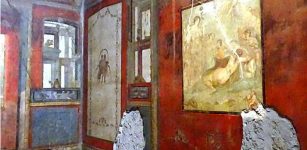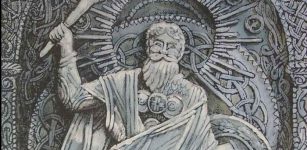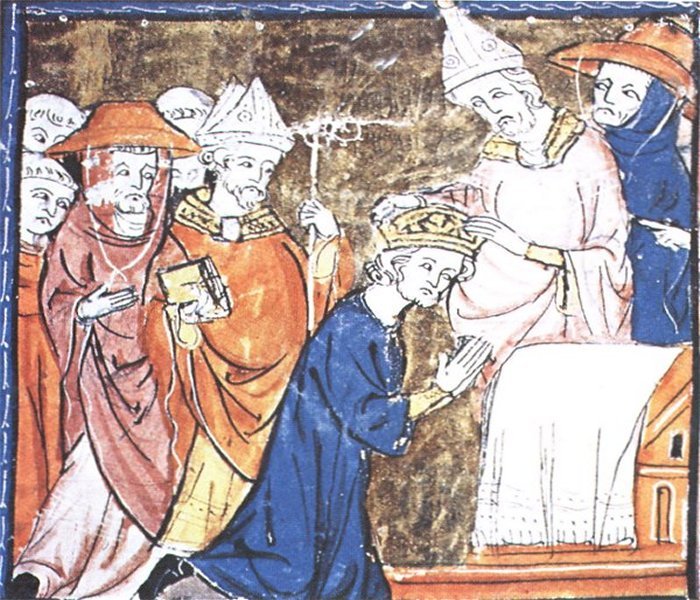Mystery Of The Controversial Phantom Time Hypothesis
Ellen Lloyd - AncientPages.com - One of the most intriguing and highly controversial theories dealing with ancient history is, without a doubt, the "Phantom Time Hypothesis."
The coronation of Charlemagne by Pope Leo III. source
According to this unconventional and thought-provoking theory, the Early Middle Ages (614-911 AD) never existed because the Western calendar was misdated.
German scientist Heribert Illig developed the Phantom Time Hypothesis. Another German researcher, Hans-Ulrich Niemitz, expanded on this theory after accidentally learning about the problem of faked documents in the Middle Ages.
In his science paper "Did the Early Middle Ages Really Exist?" Dr. Hans-Ulrich Niemitz points out that we can find medieval falsifications in every document. There are thousands of recognized forgeries from the Middle Ages. People forged wills, history texts, land deeds, and more. The Church falsified documents and relics regularly, too.
Since people didn't own clocks, they couldn't track days like we do today.
To find out what day it was, they asked a priest.
Early Middle Ages. Credit: Public Domain
These are facts that speak in favor of the Phantom Time Hypothesis.
"The easiest way to understand doubts about the accepted chronology and 'well-known' history is to systematize medieval research problems systematically.
It will lead us to detect a pattern that proves my thesis and gives reason to assume that a phantom period of approximately 300 years has been inserted between 600 AD and 900 AD, either by accident, misinterpretation of documents, or by deliberate falsification.
This period and all events that are supposed to have happened therein never existed. Buildings and artifacts ascribed to this period belong to other periods, "Dr. Hans-Ulrich Niemitz says.
The Western calendar should have been revised because Holy Roman Emperor Otto III, in collusion with Pope Sylvester II, wanted to celebrate the end of the first millennium 297 years earlier.
The scientists could elaborate further on the Phantom Time Hypothesis by examining several curious historical gaps.
"We looked for 'gaps' in special reports and publications, also for periods of stagnation or strange events repeated similarly after approximately 300 years. I only refer to some of a great number of puzzles: a gap in the history of the building in Constantinople (558 AD - 908 AD), a gap in the doctrine of faith, especially the gap in the evolution of theory and meaning of purgatory (600 AD until ca. 1100), a 300-year-long reluctant introduction of farming techniques (three-acre-system, and of war techniques (stirrup), a gap in the mosaic art (565 AD - 1018 AD), a repeated beginning of the German orthography etc. etc. The puzzles of historiography led the way, pointing out, again and again, the 'gap' which we soon termed 'phantom time.'"
One of the most startling proposals is that Charlemagne, also known as Charles the Great and widely recognized as the Father of Europe, was a fictional character who lived in an imaginary time.
According to Dr. Hans-Ulrich Niemitz, there are two reasons why the 'fakers' needed a phantom time of 297 years.
The Bust of Charlemagne, an idealised portrayal and reliquary said to contain Charlemagne's skull cap, is located at Aachen Cathedral Treasury, and can be regarded as the most famous depiction of the ruler. Image credit: Florian B. Gutsch - CC BY-SA 4.0
Hypothesis 1 states, "Otto III didn't live accidentally around 1000 AD; he had defined this date! He wanted to reign in this year because this suited his understanding of Christian millennialism. He explained this date with the help of his famous and well-versed friend Gerbert de Aurillac, later Pope Sylvester II.
In reality, they lived approximately seven hundred years after the birth of Jesus Christ, but only then had the years been reckoned 'after Christ.' Perhaps unaware of their error and without intending to falsify, they defined one particular year as '1000 AD' (Illig 1991). Consequently, chroniclers had to invent 300 years of history. To fill empty periods - what a great occasion for dynasties and kings!"
Hypothesis 2 states, "Constantine VII of Byzantium (905 - 959 AD) organized a complete rewriting of Byzantine history."
So, is the Phantom Time Hypothesis true? We do not know that.
It is impossible to tell now because this theory requires much more research. If the Phantom Time Hypothesis is correct, our calendar year was increased by 297 years without the corresponding passage of time. It means that our current year is not 2019 but 1722.
Written by Ellen Lloyd – AncientPages.com
Updated on Sep 25, 2023
Copyright © AncientPages.com All rights reserved. This material may not be published, broadcast, rewritten or redistributed in whole or part without the express written permission of AncientPages.com
More From Ancient Pages
-
 Isaiah: Prophet Who Predicted The Coming Of Jesus Christ To Salvage Mankind From Sin
Biblical Mysteries | Apr 4, 2019
Isaiah: Prophet Who Predicted The Coming Of Jesus Christ To Salvage Mankind From Sin
Biblical Mysteries | Apr 4, 2019 -
 What Was The Sphinx And What Is Wrong With Its Body And Head?
Civilizations | Apr 6, 2017
What Was The Sphinx And What Is Wrong With Its Body And Head?
Civilizations | Apr 6, 2017 -
 Old Cannon Found At Construction Site
Archaeology | Apr 22, 2020
Old Cannon Found At Construction Site
Archaeology | Apr 22, 2020 -
 Roman Sexuality Was Far More Complex Than Simply Gay Or Straight – Pompeii’s House Of The Vettii Reveals Why
Featured Stories | Jan 24, 2023
Roman Sexuality Was Far More Complex Than Simply Gay Or Straight – Pompeii’s House Of The Vettii Reveals Why
Featured Stories | Jan 24, 2023 -
 World’s Oldest Wooden Structure Discovered And It Predates Homo Sapiens – Archaeologists Say
Archaeology | Sep 20, 2023
World’s Oldest Wooden Structure Discovered And It Predates Homo Sapiens – Archaeologists Say
Archaeology | Sep 20, 2023 -
 Intact 1,800-Year-Old Roman Sarcophagus With Unexpected Treasures Found In France
Archaeology | Sep 26, 2023
Intact 1,800-Year-Old Roman Sarcophagus With Unexpected Treasures Found In France
Archaeology | Sep 26, 2023 -
 Artifacts And Long History Of Unguja Island – Ancient Humans Impact Island’s Environment
Archaeology | Mar 5, 2022
Artifacts And Long History Of Unguja Island – Ancient Humans Impact Island’s Environment
Archaeology | Mar 5, 2022 -
 Unusual 2,500-Year-Old Face Urns Reveal Garments, Appearance And Jewelry Of Prehistoric People
Archaeology | Nov 11, 2017
Unusual 2,500-Year-Old Face Urns Reveal Garments, Appearance And Jewelry Of Prehistoric People
Archaeology | Nov 11, 2017 -
 Prehistoric Humans Recycled Old Stone Tools To Preserve The Memory Of Their Ancestors
Archaeology | Mar 17, 2022
Prehistoric Humans Recycled Old Stone Tools To Preserve The Memory Of Their Ancestors
Archaeology | Mar 17, 2022 -
 Immortal Mimi Spirits In Beliefs Of Aborigines Of Arnhem Land
Featured Stories | Mar 26, 2020
Immortal Mimi Spirits In Beliefs Of Aborigines Of Arnhem Land
Featured Stories | Mar 26, 2020 -
 Unique 9,000-Year-Old Shrine With Symbols Discovered At Neolithic Ritual Site In Jordan Desert
Archaeology | Mar 7, 2022
Unique 9,000-Year-Old Shrine With Symbols Discovered At Neolithic Ritual Site In Jordan Desert
Archaeology | Mar 7, 2022 -
 Ancient Indian Sages Had Highly Advanced Scientific Knowledge Thousands Of Years Ago
Ancient Technology | Mar 18, 2019
Ancient Indian Sages Had Highly Advanced Scientific Knowledge Thousands Of Years Ago
Ancient Technology | Mar 18, 2019 -
 Rare Gladiator Tombs Found In Ancient City Of Anavarza In Southern Turkey
Archaeology | Aug 16, 2022
Rare Gladiator Tombs Found In Ancient City Of Anavarza In Southern Turkey
Archaeology | Aug 16, 2022 -
 Veles And Perun: Most Powerful Slavic Gods In Conflict Between Powers Of Light And Darkness
Featured Stories | Jun 26, 2017
Veles And Perun: Most Powerful Slavic Gods In Conflict Between Powers Of Light And Darkness
Featured Stories | Jun 26, 2017 -
 Ggantija Double Temple On Malta Is Older Than Stonehenge And Great Pyramid Of Giza
Civilizations | Jan 16, 2023
Ggantija Double Temple On Malta Is Older Than Stonehenge And Great Pyramid Of Giza
Civilizations | Jan 16, 2023 -
 2,500-Year-Old Large Untouched Scythian Burial Ground Unearthed In Khakassia, Siberia
Archaeology | Oct 6, 2020
2,500-Year-Old Large Untouched Scythian Burial Ground Unearthed In Khakassia, Siberia
Archaeology | Oct 6, 2020 -
 God Odin Was Exiled From Asgard – The Kingdom Of The Gods – But He Had No Regrets For Breaking Norse Society’s Norms
Featured Stories | Feb 10, 2018
God Odin Was Exiled From Asgard – The Kingdom Of The Gods – But He Had No Regrets For Breaking Norse Society’s Norms
Featured Stories | Feb 10, 2018 -
 Hidden Text Of Medical Book By Doctor Galen Read For The First Time In 1000 Years
Archaeology | Mar 24, 2018
Hidden Text Of Medical Book By Doctor Galen Read For The First Time In 1000 Years
Archaeology | Mar 24, 2018 -
 Neanderthals Were Present In Italy Much Earlier Than Previously Thought
Archaeology | Nov 6, 2015
Neanderthals Were Present In Italy Much Earlier Than Previously Thought
Archaeology | Nov 6, 2015 -
 Unique Bronze Age Treasure Discovered In Swedish Forest Was A Gift To Norse Gods
Archaeology | Apr 30, 2021
Unique Bronze Age Treasure Discovered In Swedish Forest Was A Gift To Norse Gods
Archaeology | Apr 30, 2021



